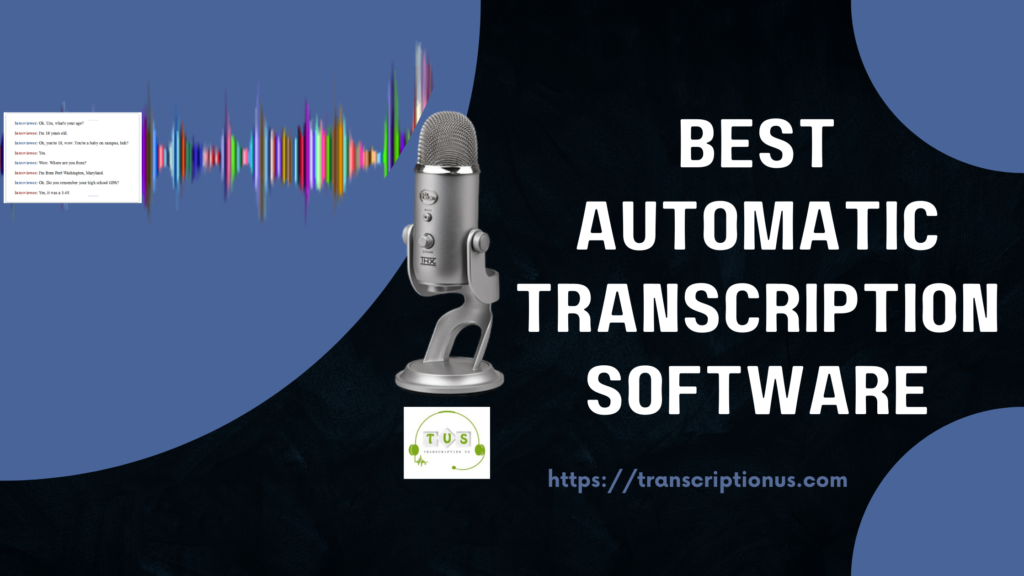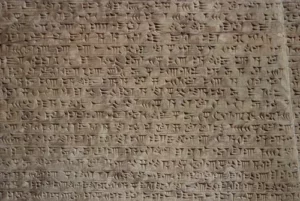
Automatic Transcription Software
Automatic Transcription Software converts prerecorded audio or live recording into readable text without human interference. Automatic transcription software uses advanced artificial intelligence (AI) and Natural Language Processing to listen to the audio and convert it into legible text version. The processing speed is pretty quick.
Transcription service, or speech to text, is in great demand. Journalists, researchers, lawyers, business companies and medical practitioners require transcription service very frequently. There are various options available to them in the form of in-house transcriptionist, real-time transcriber, online transcription company and/or automated software. They utilize human transcription services or automated transcription services based on their requirement.
Before jumping to the best automatic transcription software, let me briefly discuss about the history of transcription service and the transcription methods available in the market. This will help us to understand the role of transcription in the human history.
The Journey of Transcription Services
Transcription was present from the early days of human history and it was known as documentation or record-keeping. In the modern days we use the term “transcription.” Transcription in its simplest form is an art of writing down all that is spoken in a meeting, interview or in a court hearing.

Transcription as a means of documentation began in ancient times (c. 3500-3000 BCE) and was known as cuneiform which was developed by the ancient Sumerians of Mesopotamia. The cuneiform writing system was in use till the second century AD. Subsequently during the Roman era, it was replaced by alphabetic writing.
In ancient Israel, the transcribers were known as Scribes. Jewish scribe’s responsibility was to transcribe the holy scrolls. The scribes of ancient Israel who belonged to the priestly class transcribed their oral traditions into writing that eventually became the Hebrew Bible. Other scribes were called as the record-keepers and letter-writers and they were employed in the royal palaces. Source
Renaissance gave birth to the surge of interest in Classical scholarship and values. The fall of Constantinople in 1453 provided humanism with a major boost, for many eastern scholars fled to Italy, bringing with them important books and manuscripts and a tradition of Greek scholarship. Literacy grew more among the wealthy and scribes could find more jobs.
The invention of the printing press in 1439 led to mass printing of literatures and the number of scribes needed during this period grew.
Shorthand and Stenograph: Shorthand an abbreviated system of writing based on the alphabet helped the scribes to write as quickly as people speak. Despite the digital age, shorthand is still used by journalists for transcription. The Stenograph was invented by Miles Bartholomew, a newspaper reporter, who patented his invention in 1879. His Stenograph was the first mechanical printing machine for shorthand. Till 1970s court reporters were required to use shorthand or stenographic writing to transcribe court proceedings.
Typewriters paved the way for modern transcription services as a unique industry. In 1714 Henry Mill obtained a patent for an apparatus “for impressing or transcribing of letters singly or progressively one after another, so neat and exact as not to be distinguished from print, very useful in settlements and public records”. Mechanical typing machine was invented by Pellegrino Turri at the start of the 19th century. Turri was an Italian inventor. The machine was invented for his blind friend Countess Carolina Fantoni da Fivizzano. He also invented carbon paper to provide the ink for his machine.

It was Rasmus Malling-Hansen a Danish inventor, who produced commercial typewriter and called it writing ball. It was sold worldwide. He succeeded in finding a placement of the letters that made the writing speed extremely fast. The first model was patented in 1870.
The first practical typewriter was invented by Christopher Sholes with the QWERTY keyboard layout. As he was not good in marketing tactics, he sold his rights to the Remington Arms Company (1873). Users were able to type about 130 words per minute, while they could handwrite only up to 30 words per minute. The typewriter was created and designed in order to help businesses save time and money. The typewriter was the most significant everyday business invention of the pre-computer age. And the typewriter helped transcription industry to develop in a unique way. During World Wars I and II, increasing numbers of women were entering the workforce. In the United States, women often started in the professional workplace as typists. In the 1930s, the electric typewriter was invented. During this period, offices and business companies hired secretaries. The secretary’s job was to keep the official records and typewrite the minutes of the meeting in real-time. Transcriptionists were required to be in the same room as the dictator until the digital recorders, high-speed computers and internet came into existence. Most of these were female employees and the same trend is continuing in the transcription industry till this day.
Computers: The first computers were designed by Charles Babbage in the mid-1800s. But IBM 5100 (1975) was the first, commercially successful, portable computer. It was not just the computers which brought revolution in the transcription industry but also the digital recorders, internet and online platforms all of which worked together to bring in the huge change and development. As I mentioned in the previous section, the transcriptionist needs to be available in the dictator’s room, meeting room or in the court room to typewrite the notes. The transcription was made available almost instantly. However, with the availability of personal computers, laptops, digital recorders, internet and online platforms the trend changed drastically and remote transcription services were made available by online transcription companies.
Now, the transcription industry is moving to a new phase called “Automatic Transcription Services”. Automatic transcription software is based on the artificial intelligence and automatic speech recognition (ASR), which uses natural language processing (NLP) to translate human speech into a written format. Artificial intelligence leverages computers and machines to mimic the problem-solving and decision-making capabilities of the human mind. Artificial Intelligence plays a vital role in our everyday life to power search engines, product recommendations and speech recognition systems.
Having explained the journey of transcription now let me move to the method of transcription services or various ways we can get transcription services. There are four methods you can get transcription services.
- In-house transcription
- Real-time transcription
- Online transcription services
- Automatic transcription software
In-house transcription
Traditionally in-house transcriptionist was employed by companies and called them secretaries. The in-house transcriptionist’s job is to maintain records and take notes from the dictator and be physically present in the company meetings to take down the minutes of the meeting. The secretary will use shorthand to take down the dictation or minutes of the meetings and then typewrite them or feed the same in the computer. Once the transcript is ready, the same will be forwarded to the manager, trainer or to the board of secretaries for review and approval. Having in-house transcriptionist is the best way to get transcription in a timely manner and the company’s secrecy will be maintained all the time.
This began to change a little over 20 years ago when corporate companies, insurance companies, educational institutions began outsourcing recorded audio to various transcription service providers. The main reasons for outsourcing transcription services are accuracy and cost-effectiveness.
Real-time transcription
Real-time transcription is provided by a professional who is located in a remote place but connected over a phone call or video conferencing module. Usually these transcriptionists are working in a transcription company, well-trained to listen and type them out in live environment. The challenge here is that the professionals cannot playback (rewind) to listen to the missed-out words. Transcriptionists in this field are expected to have a speed of 200 to 300 words per minute. Corporate companies hire their services in order to produce transcripts instantly.
Educational institutions utilize this service for the students who are deaf and hard of hearing or those for whom English is not their primary language. The service is produced at speeds up to 275 words per minute. The caption will be available on computers, screens, monitors or smartphones. The student can view the transcription in real time.
The real-time transcription service is very expensive and it is not suitable for small business and research scholars.
Online transcription services
Online transcription services has grown vigorously in the last 2 decades as it is done by professionals and delivered with guaranteed accuracy. Online transcription services are also in-expensive and convenient. The users are expected to record the audio in digital format, upload it through the online widget and the transcript is delivered on due date to the email. The transcriptionist will listen to the recorded audio and transcribe it in the format you want. The most common formats needed by the clients are strict verbatim transcription and intelligent verbatim transcription. As the transcriptionist listens to the recorded audio, he/she will be able to playback and capture even the most difficult terms. These professionals rely on equipments like Express Scribe, foot pedals, computers and the internet.
Online transcription services produce highly accurate transcripts even if it is a meeting audio, conference call or focus group recording. The service provider will allocate your audio to the talented transcriber based on the topic discussed. This will ensure accuracy every time.
At the same time online transcription is cost-effective. When you employ full-time transcription staff in house, you will have to pay for wages, overtime and equipment. However, outsourcing the same to an online transcription company is straight forward and you only pay for the service. You avoid overhead charges. Outsourcing frees up your workers for other important admin work. In the same way researchers can concentrate on their studies and research instead of wasting time on transcribing and proof-reading.
Automatic transcription software
As we have seen in the previous section, automatic transcription software does the work for you in a matter of seconds as it is AI powered. Many developers worked on the automated system for the last 10 years and came up with a sophisticated system to produce transcripts with the help of natural language processing (NLP) to translate human speech into a written format. Today, there are few claim that the automatic transcription software produces accurate transcripts when the audio has one voice and for the interviews recorded without background noise. However, you cannot expect highly accurate transcripts, as is obtained from online transcription services. While you may need to review your transcripts for accuracy, you will still end up saving a lot of money by letting the software automatically transcribe your audio recording and/or video to text. For this reason, journalists, video producers and researchers prefer using automatic transcription.
In this article I have listed the best automatic transcription software based on their accuracy, compatibility with other platforms and user friendliness. I believe that this will help you choose the one that best fits your needs.
Best Automatic
Transcription Software

1. Descript
Descript is a collaborative audio/video editor that works like a doc. It includes transcription, a screen recorder, publishing, and some mind-bendingly useful AI tools. Among all the automatic transcription software, Descript ranks first due to the accuracy and the collaboration tools. You can upload audio file or record directly in Descript to transcribe the audio into text. You get the transcript almost instantly and the interface allows you to edit directly. Descript automatic transcription software is capable of automatic speaker detection which is great. You will be also able to remove the filler words and silence gaps with a single click. Automatic captioning and multi-track editing features are available in the Pro version. Altogether the users feel happy to use Descript as the toll is easy to use.
While no automatic transcription software will ever be perfect, Descript’s editing interface makes correcting transcription errors fast and simple.
Price:
Free: 3hrs of transcription
Creator: $12/editor /month – 10hrs of transcription/month
Pro: $24/editor /month – 30hrs of transcription/month

2. Otter
Otter is a great option for anyone who wants to convert audio to text in real time or pre-recorded audio. It is an online app that allows users to make audio recordings and transcribe them in real-time. It enables users to record and automatically transcribe conversations using either their phone or their computer. This automatic transcription software has the ability to recognize and differentiate between different speakers. This app allows users to edit and manage transcriptions. Users will be able to play back the audio in different speeds in order to edit or add content directly into transcriptions. Otter automatic transcription software is compatible to import audio and video files that need to be transcribed.
Reporters prefer Otter as they spend countless hours sifting through and transcribing interviews and meetings for every story. Otter basic plan is free and allows anyone to process 600 minutes of audio to text conversions. The free option draws most of the reporters to use Otter automatic transcription software and popular among them. Otter has multiple functions that allows one to import recorded files, live audio and website links for transcription and the options are limitless. This automatic transcription software identifies the speakers and capable of marking the time stamps that allows one to go back and review quickly.
The downside is one will have to opt for either the Pro or Business subscription in order to upload prerecorded audio and video files.
Price:
Basic Free
- Record and transcribe live up to 600 minutes
- Import prerecorded audio up to 3 files
Pro
- $8.33 per month
- Import pre-recorded files
- Otter Assistant for Zoom, Microsoft Teams, and Google Meet (limited trial)
- Add custom vocabulary
Business
- $20/user/month
- Everything in Pro +
- Otter Assistant for Zoom, Microsoft Teams, and Google Meet
- Team collaboration features

3. Trint
Trint was born in an Airbnb in Florence, Italy, in 2014. Trint is a best option for those who do not want to download software. Trint is an artificial intelligence solution accessible through a web-page that can process audio recordings to create transcriptions. Listening and writing down a recorded interview or a meeting is difficult and time-consuming. However, Trint is fast and hassle free. Once the software generates the transcript, you will be able to listen through the audio and correct errors. Those who interview a lot and podcasters find it helpful to use Trint. Trint’s automated transcription software features an excellent online editor, fast file processing, and good security policies. Trint is a best choice for those who want to use the service for simple recordings with one or two speakers. Trint supports both audio and video file uploads. Trint automatic transcription software supports 34 languages. You will be able to add closed captioning to video files.
Price:
7 day free trial
Starter pack $48/month per user
Advanced pack $60/month per user
4. Happy Scribe
Happy Scribe was originated in Dublin and this business only formed a few years ago. The automatic transcription software has already gained an excellent reputation from journalists, podcasters and researchers, who now rely on their service to process audio into text.
Happy Scribe provides machine-made transcription and subtitling services in the most common languages. Journalists, video editors, podcasters, and researchers can use Happy Scribe as this web-based application. This automatic transcription software transcribes audio and video files quickly. It will take about 20 minutes to get the first draft of an hour-long recording. It recognizes a new speaker, the Speaker Identification feature enables the app to create a new paragraph each time it recognizes a new voice.
Happy Scribe produces pretty accurate automated transcription. But brand names and industry terms are still difficult to learn. But with this tool you can immediately see questionable words. You can also review the video with a follow along by word to ensure exact and conversational transcription. This automatic transcription software has advanced punctuation capabilities that enable it to use commas, question marks, and full-stops correctly. Happy Scribe can transcribe texts in 119 languages.
Price:
€0.20 / minute
Free trial available
Accuracy up to 85%
5. Sonix
Sonix is another automatic transcription software. Sonix’s in-browser editor allows you to search, play, edit, organize, and share your transcripts from anywhere on any device. Perfect for meetings, lectures, interviews, films and any kind of audio or video. If you are looking for an affordable automatic transcription software, Sonix should be your choice. This software is trusted by over a million users. You will be able to produce automated transcription in 35+ languages including Spanish, French, German, Chinese, Hindi, Arabic, and many more.
Sonix is an online transcription platform. It is possible to directly upload files from cloud storage app such as Google Drive & Dropbox. If you upload a 30 minute audio file to Sonix, and you’ll have the transcript in less than 5 minutes. This platform has auto speaker separation feature and auto-punctuation. It also has multiuser capability and make it easy to share transcripts across team members.
Price:
30 free minutes
Standard – $10/hour
Premium – $5/hour plus $22 per user/month
Accuracy – The system’s workflow does require human review to ensure grammar, words, etc., are correct.
6. Vocalmatic
Vocalmatic is an automatic transcription software created by a Canadian company Enactics Inc. Vocalmatic is basic transcription software but simple to use for even those with limited computing skills. Users can upload their audio (.mp3, .flac, .wav) or video (.mp4, .mov, .ogg, .webm) to Vocalmatic. Vocalmatic will convert the audio to text using artificial intelligence. Once the automatic transcription has completed, you will receive a link to your email where you can edit. Vocalmatic allows you to save the file as Raw Text or a Word document. And Vocalmatic does not have the speaker recognition capability.
Vocalmatic is not fast as other automatic transcription software. The duration depends on how busy the Vocalmatic servers are. So typically, it will about 30 minutes to get the transcribed text for a 30 minute interview recording. Once the file is processed, you can go to the editor and make some adjustments to the formatting and content.
Price:
30 minutes of automatic transcription for free
1 hour – $15
2 – 9 hours – $10/hour
10-14 hours – $9/hour
Accuracy – 80% for clear audio
7. Temi
Temi is an automatic transcription software that relies on automatic speech recognition (ASR) to process audio files. Temi’s web dashboard looks good but doesn’t offer much functionality. Though Temi claims to use advanced speech recognitions to convert audio to text, if your recording or audio file is complex or the sound is iffy, Temi is not a great option.
Transcribing with Temi is a straightforward process that only requires you to upload the audio file, edit the transcript, and download the completed transcript. The software is web-based automatic transcription software that identifies different speakers and allows one to create custom timestamps. However, it takes time to polish the converted text file. Temi can be used from the web browser or can be installed on your Android or your iPhone and convert all audio or video content you capture with your Smartphone just moments after recording it. The accuracy depends on the quality of recording. You will be able to download the transcript in MS Word or PDF format.
Price:
Free Trial: 45 minutes
No subscriptions – $0.25 per audio minute
Accuracy: 90% for clear audio
Difficult Audio: Mostly Unusable
8. Rewatch
Rewatch is a collaborative video tool that helps teams stay connected. Rewatch helps you to manage and save all your video meetings in one place. And it allows teams to search your meeting recordings and company videos in a secure environment.
In Rewatch, every video is automatically transcribed into readable content. The readable content helps participants to have a meaningful meeting. Team member can also search and find the information at their convenience. Rewatch transcripts are power by AI speech engine and the company claims that the transcripts are highly accurate. Rewatch also claims that the speech technology has been trained on 50,000+ hours of human transcription content from various industries, topics and accents.
Rewatch is inexpensive and easy to integrate or upload videos. Once the automation process is completed you will be able to add speaker names, edit details and highlight any relevant information. While the transcript is not accurate, it is great for those prefer verbatim transcription and have enough time to proofread the text.
Price:
Startup $6 / per user / per month
Business $12 / per user / per month
Integrate: Zoom, Google Meets, Stack
9. VEED
VEED is basically a video editing tool. VEED helps to make professional video in simple steps. It offers online video editing, recording, hosting and sharing. Important characteristics include one-click subtitling, translation, noise reduction, cropping, transitions, custom branding, compression and format conversion. VEED is ideal for teams as it is cloud based.
VEED’s automatic transcription software allows you to transcribe audio and video files into text in just one click. It is much more flexible compared to other services that only allow you to transcribe either an audio or a video file. All you have to do is to upload the audio or video file and click on “Auto Transcribe” to download the transcript.
10. Maestra
Maestra the go-to solution for automatic transcription, captioning, and voiceover software turns your audio and video files incredibly fast. Maestra processor will transcribe, caption or voiceover your audio or video files. The tool allows you to easily edit the automatically generated transcripts and export the transcript in Word, PDF, and TXT formats. The interface allows you to instantly share the transcripts online with just a single click. Maestra is also capable of translating videos into so many different languages in just minutes. The best feature in this software is voiceover.
Price:
Pay as you go: $10/hour
Pay for the amount of work done.
Best option for individuals
Premium Subscription
Annual: $19/per user
Monthly: $29/per user
11. Fireflies
Fireflies is an automatic transcription software designed to assist video meetings. You can host web-conferencing through any platform and invite Fireflies to record your meeting. Fireflies transcribe both live meetings and recorded audio file. And the company claims that you can review an hour long call in less than 5 minutes, which is doubtful.
The advantage with this automatic transcription software is that you can integrate all the leading web-conferencing platforms like Zoom, Google Meet, Webex, Microsoft Teams and more.
Price:
Free:
- Limited transcription credits
Pro:
- $10 Per seat/month
- Unlimited transcription credits
- Download transcripts & recordings
- AI meeting summaries
Business:
- $19 Per seat/month
- n-depth meeting summaries
12. Grain
Grain, the automatic transcription software which turns all your video meetings into actionable transcripts. You will be able to record, transcribe and share important moments from video meetings with Grain. Companies use Grain as a source of truth to grow revenue with better selling, capture the voice of the customer, hire better talent, and share valuable insights for product and research teams. You can also integrate Grain with Zoom, Slack, Salesforce, Google and more. Therefore, if your organization or business utilizes regular video meetings Grain will be of great resource.
Price:
Free:
- Unlimited users and recordings for 30 days
- 10 Recordings and Transcripts
Business:
- $19 / user / month
- Unlimited Recordings and Transcripts
13. Vowel
Vowel is a tool for remote teams to host video conferencing and to produce live transcription. Vowel has been launched in 2020 and has become a popular tool for video conferencing due to its capability to produce transcription or meeting notes instantly. When you use Vowel, you don’t have to download the automatic transcription software separately or to cobble together a bunch of different tools.
Vowel combines video conferencing with live meeting transcription and notes. So you will not need to spend 4 to 5 hours of your time after the conference to transcribe the audio. You can quickly review the automated transcript produced by the software and distribute with your group. Therefore, typically you will need to spend 2 to 2:30 hours for an hour of meeting conducted through Vowel.
Price:
Free:
- Unlimited meetings for up to 50 minutes
- Record and transcribe all your meetings
- Host up to 12 participants per meeting
Pro:
- $8.49 USD per member/month
- Unlimited meetings for up to 120 minutes
- Rewatch and search through past meetings for 60 days
- Host up to 25 participants per meeting
- Advanced transcription
- Non-English transcription languages
Business:
- $16.49 USD per member/month
- Unlimited meetings for up to 10 hours
- Rewatch and search through past meetings forever
- Host up to 50 participants per meet
- Custom transcription vocabulary
14. Murf
Murf is automatic transcription software with a versatile AI voice generator. What makes Murf stand out among other text to speech software is the fact that as an online voice generator, Murf lets you create quality outputs instantly.
Though Murf is cloud-based automatic transcription software, it can be used to create voiceovers for their content. So it is great software for YouTubers, podcasters, advertisement companies and audiobook publishers. When you subscribe you have the access to natural-sounding voiceovers. So you don’t have to invest hundreds if not thousands of dollars in hiring voice artists.
Price:
Free:
- 10 mins of voice generation
- 10 mins of transcription
- No downloads
Basic:
- $13 per month
- 24 hours of voice generation/year
- Access to 60 voices
- Unlimited Downloads
Pro:
- $26 per month
- 96 hours of voice generation/year
- 48 hours of transcription/year
- Access 120+ voices
15. Versational
Versational, automatic transcription software transcribes and recaps 60 minutes of meetings into 6 minutes of takeaways. The 6 minute takeaway points help you to get the most value from your meetings. Versational identifies and extracts what’s important in every conversation. Versational combines the power of human and artificial intelligence to extract key phrases based on the topics.
While using Versational you can quickly export your synopsis, takeaways, best mentions, and transcript. You can share summary, specific highlights, or entire conversation with your time in a timely manner.
Price:
Monthly subscription: $22 / month per user
Annual subscription: $15 / month per user
Transcript accuracy rate: >90%
Conclusion:
Automatic transcription software is certain to help individuals, reporters and podcast producers to save a lot of money. No software is guaranteed to produce accurate transcript. Therefore, you need to spend some time on editing. You can improve the editing speed as you learn the tool and process. I believe that the above review might have helped you to choose the one that best suits you.
Do you have a suggestion about reviewed software? Would you like to add another product or your own product to this list? If so, please leave your comments below–I’d love to read them.
Disclaimer: Information presented in this article is intended for informational purposes only and is not meant to be taken as financial advice. Any action you take upon the information you find on this article, is strictly at your own risk. We will not be liable for any losses and/or damages in connection with the use of our website.
Article by: Livingston D
Great information!!! Thanks for your wonderful informative blog.